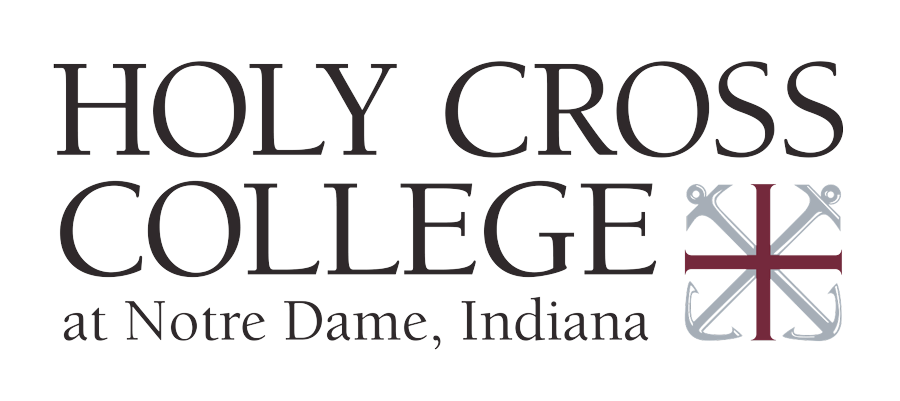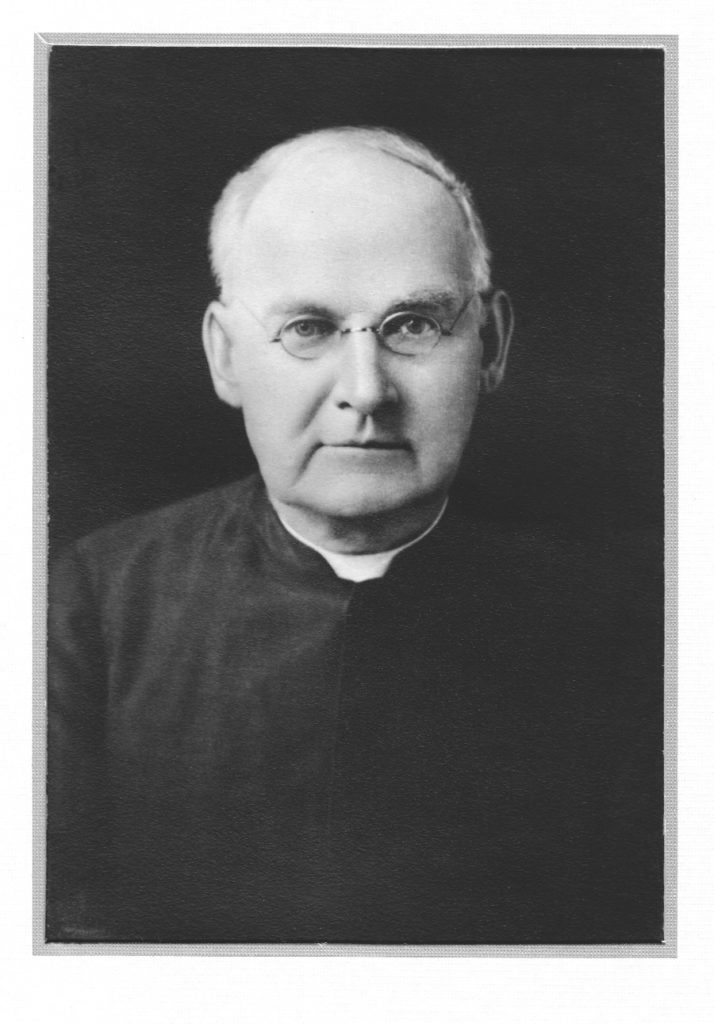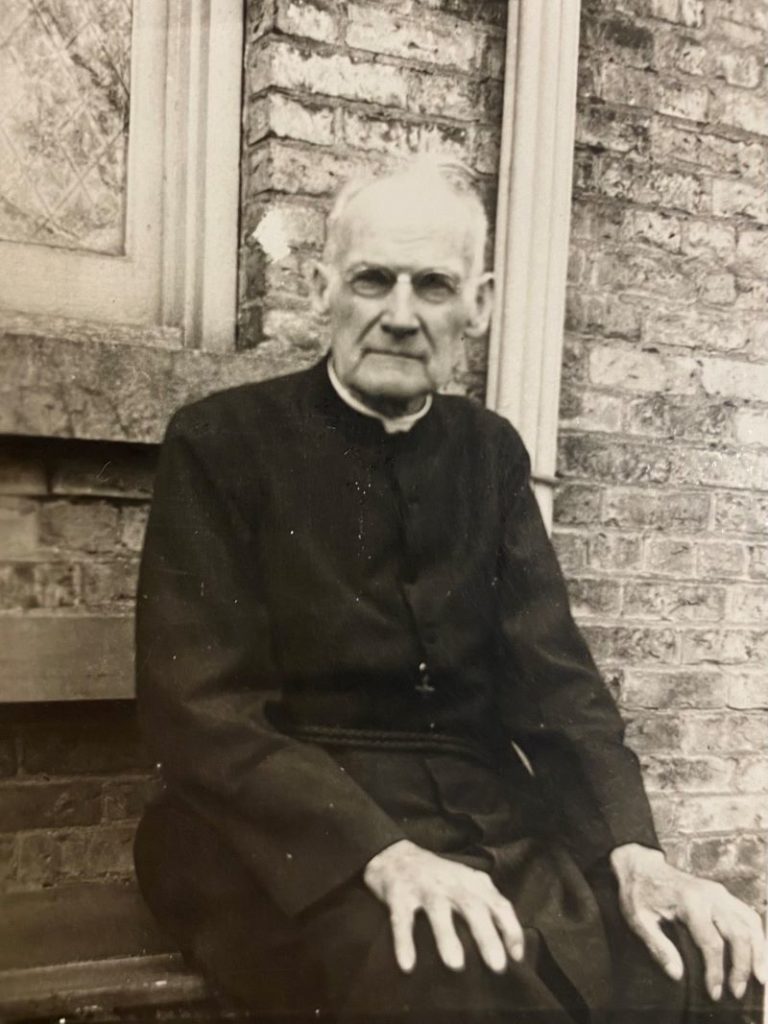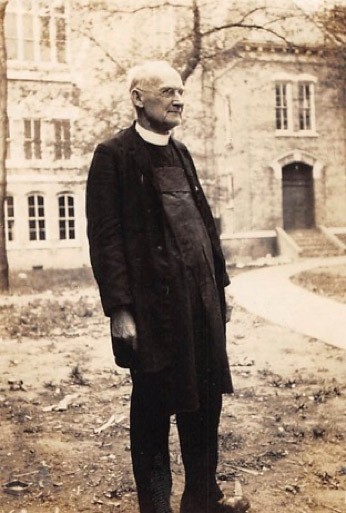By Brother Philip Smith, C.S.C.
I came to South Bend in April of 2019 to assist in the Midwest Province Archives, and, eventually, to become the archivist. About eighteen months into the work of finding my way around the many shelves and boxes of historical documents, I came upon three large storage boxes labeled Brother Columba O’Neill: Correspondence. These were pushed far back on a shelf where they should not have been stored. I had heard of this Brother. He was the University of Notre Dame “crippled” cobbler from about 1890-1923. Brother Columba was a holy brother.
Intrigued, I lifted one box off the shelf onto the floor, removed the lid, and was amazed to find hundreds upon hundreds of letters beginning in1912 and ending with those written six months after Brother Columba’s death on November 20, 1923. I lugged the boxes from the stacks into the workroom and like Odysseus, launched my ship upon the meandering and deep sea of this humble, crippled cobbler of the University of Notre Dame.
Similar to St. André Bessette, C.S.C, Brother Columba came from a poor, devoted, and humble background. Born John O’Neill in Mackeysburg, Pennsylvania in 1848, he was the fifth son of six children born to Michael and Ellen (McGuire) O’Neill. Twins were born in Kilkenny, Ireland and four more children in Mackeysburg, one of the scores of small mining camps in Pennsylvania. Sometime in the mid-19th century, these camps were gathered together and were known as Minersville. Miners and their families either gathered slate or dug for coal. In Bother Columba’s biography “These Two Hearts,” by Brother Ernest Ryan, C.S.C., the author of this scant fifty-seven-page book, speaks of Brother Columba’s father, Michael, of Irish descent, living in Mackeysburg which “sent it quota of men” to fight for the Union. His son John (Brother Columba) left Mackeysburg for Colorado and then on to California apprenticed to a shoemaker. He was 14 years old in 1862.
It was in California that John met an itinerant cobbler who told him that he had learned his trade at the Manual Labor School on the grounds of a place called the University of Notre Dame. Biographer Ryan uses his imagination to describe John’s reaction. “While looking toward the heavens a strange light seemed to come into John O’Neill’s eyes and a strange feeling of peace flooded his soul. Could it be that it was to Notre Dame that God was calling him? Would he with his misshapen feet be admitted into the Brotherhood?” John O’Neill was called to the Brothers and would be admitted!
Historical records indicate that John made his way to Indiana, to Notre Dame, and eventually, into the office of Father Edward Sorin, the school’s president. He was met at the university gate by porter Brother Francis Xavier Patois and by novice master Father Augustin Louage. This was in 1874, and John, the soon-to-be Columba, was admitted to the Brothers because, for Father Sorin, no man or woman offered a gift that was too small when it came to the president’s desire to foster the growth of Holy Cross and Our Lady’s University on the two lakes in South Bend, Indiana. When Sorin realized that this newcomer was a cobbler and a shoemaker, he was warmly welcomed.
Brother Columba was a professed member of Holy Cross for 49 years—all of them as a cobbler, but not all of those years at Notre Dame. Initially, he offered to go to either Bengal or Molokai, and over the next 45 years, he petitioned two provincials and the superior general to grant that request. Upon his death and burial in late November 1923, Brother Columba’s “wonderful cures” were known across the United States and in many foreign countries. Devotees of the Sacred Heart of Jesus reached out to him because of his intercessory ability with the Son of God on their behalf. During his lifetime, he was widely known as the Divine Healer and the Miracle Man of Notre Dame.
In May of 2021, I had gathered enough information about the Divine Healer to reach out to South Bend/Fort Wayne Bishop Kevin Rhoades. I wanted to share with him what I was beginning to pull together and to ask for direction. Expecting that I would be asked to meet the bishop in Fort Wayne, I was surprised when he wanted to come to South Bend and meet me in the archives on June 10. He and I spent over three hours in the archives and another hour at Notre Dame’s Holy Cross Cemetery where Brother Columba is buried. When we parted ways, I felt energized by the bishop’s enthusiasm for the cause. On June 14, Bishop Rhoades wrote a letter in support of the furthering the Columba research and his support for beginning the Cause for Servant of God Brother Columba.
On June 28, a diocesan canon lawyer called the archives asking three questions about Brother Columba: what is the year of his death (1923); where he died (in the Community House on the campus of the University of Notre Dame); and if he died a martyr (no). Because Columba died one hundred years ago in November of 2023, his cause is an ancient one: there would be no one alive who knew him to be interviewed.
My work on Columba’s letter and document collection had barely begun. Initially, it took several months of 2020 to put the items in chronological order. Once that task was completed, the tedious work began of making copies of each original letter; reading each of the letters, and making a bullet point summary to identify those that spoke of “favors received” or “wonderful news” or “thanksgiving for a marvelous cure.” Some letters had a brief or no description of the “favors received,” and others were very detailed. These letters would need to be pondered over by other eyes than just mine. Was there evidence that could be provided as proof of Columba’s holiness, his heroic virtue and having the ear of God?
On August 9, the birthday of St André Bessette, the canon lawyer wrote: “I read through the letters from Brother Columba as well as the document you originally sent. In my opinion, it is worth initiating his cause for canonization. I base this opinion on the evidence which you have provided, namely, the innumerable success of Brother Columba’s intercessory prayer both during his lifetime and after his death.” Two suggestions were also offered for continuing the work: there should be some evidence for Brother Columba’s heroic virtue; and the petition ought to persuade the Bishop why he would consider accepting it and opening his cause for canonization.
All Christians are called to be saints. In official Church procedures there are three steps to sainthood after the cause is opened by the presiding bishop: a candidate becomes “Venerable,” then “Blessed” and then “Saint.” Venerable is the title given to a deceased person recognized formally by the pope as having lived a heroically virtuous life or who offered their life through martyrdom. To be beatified and recognized as a Blessed, one miracle acquired through the candidate’s intercession is required in addition to recognition of heroic virtue or offering of life. Canonization requires a second miracle after beatification. The pope may waive these requirements. A miracle is not required prior to a martyr’s beatification, but one is required before canonization. The designation of Servant of God is the title given to a candidate for sainthood whose cause is still under investigation, prior to being declared Venerable.
The petitioner is the party initiating an action in canon law through an appeal to the presiding bishop of a diocese. In the case of Brother Columba there are two petitioners: the Midwest Province of Brothers of the Congregation of Holy Cross and The United States Province of Priests and Brothers of the Congregation of Holy Cross.
The bishop appoints a postulator to guide and oversee the cause. Brother Philip Smith, C.S.C. is postulator for Brother Columba, and he will oversee the cause at the diocesan or eparchial level. Once Phase I is concluded, a Roman postulator will be appointed to oversee all aspects of Phases II (beatification) and Phase III (canonization as a saint). The diocesan postulator’s major task is the writing of the Positio. This is a comprehensive summary of all documentation of a candidate’s life and heroic virtues or offering of life, or martyrdom.
I delivered the positio to Bishop Rhoades on October 28, 2022, at the Motherhouse of the Franciscan Sisters of Perpetual Adoration in Mishawaka, IN. We talked for about an hour, and when I parted, the bishop informed me that he would have a decision about the formal opening of the cause as soon as possible. Having never worked on a cause for canonization before, I naively thought that I would receive word from the bishop within a month or two. Actually, it was nine months later, on June 24, the feast of the Sacred Heart, that the positio was accepted. June 25 is the feast of the Immaculate Heart of Mary. These feast days could not be more appropriate as they so thoroughly imbued all that Brother Columba lived for.
The cause is now in the first of three consultations: the first with the faithful in the South Bend/Fort Wayne diocese and surrounding areas; the second with the USCCB (United States Conference of Catholic Bishops); and the third with the Congregation for the Cause of the Saints in Rome. Now that the faithful have been informed about the life and holiness of Brother Columba, they are requested to offer their comments. This will mostly likely happen at the parish level. The USCCB meets every six months in November and June. When the bishops sign off, then the positio is sent to Rome where a postulator is assigned to the case. Once the Congregation for the Cause of the Saints is satisfied that Brother Columba led a life of heroic virtue, the findings will be sent to the pope. If accepted, Servant of God Brother Columba will then be known as Venerable Brother Columba.
So, why would the canonization of Brother Columba (John) O’Neill, C.S.C. be of usefulness to the universal Church? Generally, because the lives of ordinary men and women who are holy in spite of their ordinariness are always useful for the edification of God’s holy people. Specifically, Brother Columba’s life orbited around devotion to the tender hearts of Jesus and Mary. The heart, the organ we traditionally associate with loving, reminds us of God’s unconditional love for us. It also calls us to love as expansively as Jesus and his mother did. The psychiatrist Harry Stack Sullivan defined healthy adult maturity as “a state in which tenderness prevails.”
The example of Brother Columba’s love and compassion for every suffering human being will foster the question among the faithful: “How expansive is my love?” By comparing their lives to those of the saints, especially those saints whose lives are eminently sane and human, the faithful are encouraged to live their own flaws and foibles unto the betterment of the lives of all their brothers and sisters. This is especially significant today in a world and a nation that is becoming increasingly tribal and xenophobic with little tolerance for those who do not measure up to individual definitions of normal, ordinary, acceptable, worthy, or good. The Divine Healer, the Miracle Man of Notre Dame, Brother Columba, “worked till in the course of time and the providence of God the cobbler’s shop itself became a shrine. The humble shoemaker had somehow learned to mend immortal souls.” These words of Provincial Father Charles O’Donnell, spoken at Brother Columba’s funeral mass, can only be followed by Jesus’ expectation of Brother Columba and of us. That we “learn of Me because I am meek and humble of heart.” Servant of God Brother Columba intercede for us.
Photos provided by Brother Philip Smith, C.S.C.
